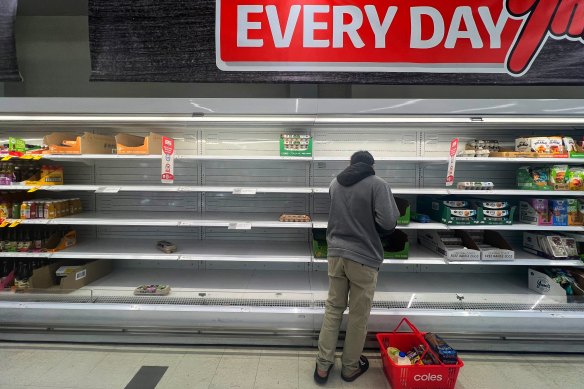
Economists say that when demand exceeds supply, the stuff still available has to be rationed, one way or another. One way to ration supply is simply to keep selling at an unchanged price until everything is sold. After that, everyone who comes later misses out.
But when the seller raises their price, economists call this “rationing by [higher] price”. They believe this is always the better solution to the rationing problem because it does so in a way that uses the “market mechanism” to fix the problem.

Disruptions to supply chains led to empty shelves during the COVID-19 pandemic.Credit: Sam Mooy
The higher price encourages would-be buyers to reduce their demand – by wasting less of the product, or finding a cheaper substitute – while encouraging suppliers to produce more of the now-more-profitable product.
So because the higher price reduces demand while increasing the supply, the price mechanism causes the price of the item to fall back towards what it first was. Brilliant. Another win for market forces.
But this means a (possibly temporary) rise in prices is an essential part of the price mechanism. So a consequent rise in profits is also an inevitable part of the mechanism.
It’s gone out of fashion but, long ago, economists would say there were two causes of inflation: “cost-push” and “demand-pull”.
Loading
Sometimes firms raise their prices because they’re passing on the higher costs they’re paying for their inputs. At other times they’re raising their prices simply because the high demand for their product allows them to.
We now know from the work of behavioural economists that ordinary consumers accept it’s OK for businesses to raise their prices because of their higher costs. But they regard raising your prices just because shortages in supply let you get away with it as exploitative. (The classic example is charging more for umbrellas on rainy days.)
This dual, supply caused and demand-caused, explanation for inflation fits well with the Reserve’s analysis of the origins of the great surge in prices – in all the developed economies – in late 2021 and 2022.
Part of it was from disruptions to supply caused mainly by the COVID-19 pandemic, but also the Ukraine war, which pushed up the cost of building materials, various manufactured goods, shipping and oil and gas. But part of it was caused by the excessive stimulus applied to the economy by governments and central banks during the pandemic and its lockdowns, which had caused the demand for goods and services to run ahead of the economy’s ability to produce them.
Increasing interest rates can do nothing to increase supply, and the end of the lockdowns would see supply gradually return to normal, the Reserve reasoned. But higher rates could dampen the excess demand caused by all the extra government spending and rock-bottom interest rates that was applied to ensure the lockdowns didn’t lead to a lasting recession.
See how this analysis is undermined by claims there’s no sign of firms earning higher profits in the post-pandemic period? It implies that there’s no sign of excess demand, suggesting the surge in prices must have come only from supply disruptions and other cost increases.
In which case, the justification for maintaining high interest rates is greatly weakened. It implies that demand hasn’t been growing excessively and, rather than waiting for the supply problems to resolve themselves, we’re going to batter down demand to fit.
Loading
If so, that would be a very painful solution to a temporary problem. And, unlike the inflation problem we suffered in the 1970s, there’s no way this inflation surge can be blamed on excessive growth in wage costs.
Real wage growth had been weak long before the pandemic arrived. And in 2020, many workers were persuaded to skip an annual wage rise in the belief that we’d entered a lasting recession. As we subsequently discovered, government handouts to business meant many businesses sailed through the pandemic with few scratches.
Why so many economists want us to believe that, despite decades of increased market concentration – more industries dominated by just a few huge firms – and despite excessive monetary and budgetary stimulus, profits never increase, I’m blowed if I know.



























